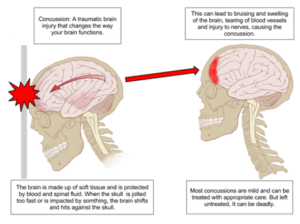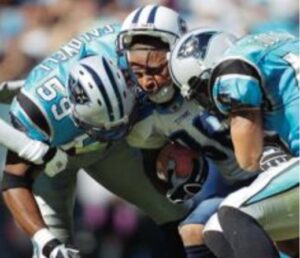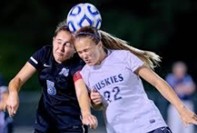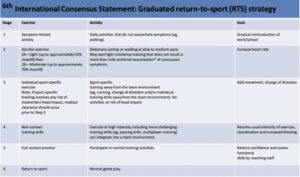What is a Sports-Related Concussion (SRC)?
A Sports-Related Concussion (SRC) is a traumatic brain injury that is caused by a direct blow to the head, neck, or body resulting in an impulsive force being transmitted to the brain during sport and exercise activities. An estimated 1.6-3.8 million SRCs occur every year according to the CDC, which is actually lower than the true prevalence as up to 50% of concussions go underreported. While the majority of SRCs resolve within 2-3 weeks, symptoms may persist for months leading to post-concussion syndrome (PCS), which is defined as at least one symptom lasting more than 30 days following a sport related concussion.

Causes of SRC:
● Collisions
● Direct impact to the head
● Falls
Acute Symptoms of SRC:
● Headache
● Dizziness
● Confusion/Disorientation
● Nausea and/or Vomiting
● Sensitivity to Light or Noise
● Difficulty Concentrating or Remembering
● Balance Problems
● Sleep Disturbances
Prevalence of Neck Pain Following a Concussion
New or worsened neck pain and stiffness is common in individuals following a concussion and negatively impacts recovery. Amongst collegiate athletes, new or worsened neck pain was reported with 47% of concussions. Similarly, among the pediatric population, neck pain after a SRC ranges between 34-54%. Not only does neck pain prolong recovery, but it also increases the likelihood that someone develops persistent post-concussion symptoms.
 Outcomes
Outcomes
● The more symptoms and more severe symptoms are at the time of the injury, the longer the recovery.
● Prior concussion appears to increase risk of experiencing a future concussion, as research shows that a player reporting 3 or more SRCs are 3x more likely to have another SRC compared to those without a prior history.
● Female athletes suffer higher rates of SRCs than their male counterparts in the same sport, with females having symptoms persist for a longer duration (nearly 2x greater risk when playing soccer, basketball, and softball).
How can Physical Therapy help with SRC?
A physical therapist will perform a thorough examination including a cognitive assessment, neck mobility measurements, and neck strength testing to assess for related cervical spine and whiplash disorders to create a customized program to get you back to your full functioning. It has been found that treatment involving the cervical spine after a concussion including massage, dry needling, manual stretching, and strengthening of the deep neck muscles has the potential to decrease the time taken to return to activities and sports ultimately improving quality of life and outcomes following a SRC. As stronger neck muscles decrease the peak head acceleration, velocity, and displacement during impact, neck strength a vital component to address. Research has shown that for every 1-lb increase in neck strength, SRC risk decreases by 5%. These results highlight the importance of neck muscle strength to better stabilize and decelerate head movements upon impact. It is recommended that athletes follow a stepwise progression during the return to play (RTP) period, which your physical therapist can help guide you through. It is important to listen to your body and respect each phase of the program as a premature RTP puts athletes at an increased risk for secondary brain injury, injuries to other parts of the body, and persistent post-concussion symptoms that can lead to chronic neurologic deficits.
How Elite Can Help!
Are you or someone in your family suffering from a SRC? If so, the experienced team of expert Physical Therapists at Elite are here to help! To learn more about Physical Therapy at Elite, click HERE! To schedule as Initial Evaluation with one of our PTs, give us a call at 781-436-9843 (Stoughton) or 774-300-3529 (Foxboro) to schedule today!

References:
1. McKeithan L, Hibshman N, Yengo-Kahn AM, Solomon GS, Zuckerman SL. Sport-Related Concussion: Evaluation, Treatment, and Future Directions. Med Sci (Basel).2019;7(3):44. Published 2019 Mar 15. doi:10.3390/medsci7030044
2. Ingram, V., Fielding, M., Dunne, L.A.M. et al. The Incidence of Sports-Related Concussion in Children and Adolescents: A Systematic Review and Meta-Analysis. Sports Med – Open 11, 36 (2025). https://doi.org/10.1186/s40798-025-00834-9
3. King JA, Nelson LD, Cheever K, et al. The Prevalence and Influence of New or Worsened Neck Pain After a Sport-Related Concussion in Collegiate Athletes: A Study From the CARE Consortium. The American Journal of Sports Medicine. 2024;52(7):1845-1854. doi:10.1177/03635465241247212
4. Wellm D, Zentgraf K. Diagnostic tools for return-to-play decisions in sports-related concussion. Journal of Concussion. 2023;7. doi:10.1177/20597002231183234
5. Oyekan AA, Eagle S, Trbovich AM, et al. Neck Symptoms and Associated Clinical Outcomes in Patients Following Concussion. J Head Trauma Rehabil. 2023;38(6):417- 424. doi:10.1097/HTR.0000000000000866
6. Cheever K, King J, Swan AA, Kawata K. Prevalence of Acute Neck Pain Following Sports-Related Concussion in High School Athletes. Clin J Sport Med. 2022;32(6):e556- e561. doi:10.1097/JSM.0000000000001047
7. Streifer, Michael, et al. The Potential Role of the Cervical Spine in Sports-Related Concussion: Clinical Perspectives and Considerations for Risk Reduction. JOSPT. 2019;49(3): 202-208. doi: 10.2519/jospt.2019.8582
8. Patricios, Jon S, et al. “Consensus Statement on Concussion in Sport: The 6th International Conference on Concussion in Sport–Amsterdam, October 2022.” British Journal of Sports Medicine, BMJ Publishing Group Ltd and British Association of Sport
and Exercise Medicine, 1 June 2023, bjsm.bmj.com/content/57/11/695.
